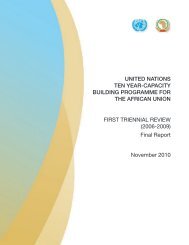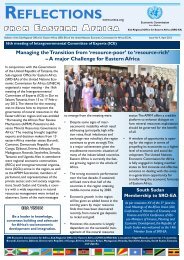A Decade of NEPAD - Economic Commission for Africa - uneca
A Decade of NEPAD - Economic Commission for Africa - uneca
A Decade of NEPAD - Economic Commission for Africa - uneca
Create successful ePaper yourself
Turn your PDF publications into a flip-book with our unique Google optimized e-Paper software.
42 A <strong>Decade</strong> <strong>of</strong> <strong>NEPAD</strong>: Deepening <strong>Africa</strong>n Private Sector and Civil Society Ownership and Partnership<br />
Concentration <strong>of</strong> FDI Flows to <strong>Africa</strong> 2004-2010 (US$ million)-Oil Exporting Countries<br />
Country 2005 2006 2007 2008 2009 2010<br />
Egypt 5,376 10,043 11,578 9,495 6,712 6,386<br />
Nigeria 4,978 4,898 6,087 8,249 8,650 6,099<br />
Sudan 2,305 3,534 2,426 2,601 2,682 1,600<br />
Tunisia 783 3,308 1,616 2,758 1,688 1,513<br />
Morocco 1,654 2,449 2,805 2,487 1,952 1,304<br />
Algeria 1,081 1,795 1,662 2,594 2,761 2,291<br />
Libya 1,038 2,013 4,689 4,111 2,674 3,833<br />
Equatorial Guinea 769 470 1,243 -794 1,636 695<br />
Angola 6,794 9,064 9,796 16,581 11,672 9,942<br />
Ghana 145 636 855 1,220 1,685 2,527<br />
Total top 10 <strong>Africa</strong>n Countries 24,923 38,210 42,757 49,302 42,112 36,190<br />
Rest <strong>of</strong> <strong>Africa</strong> 13,237 8,049 20,375 24,111 18,055 18,850<br />
<strong>Africa</strong> 38,160 46,259 63,132 73,413 60,167 55,040<br />
Flows <strong>of</strong> <strong>for</strong>eign direct investment to <strong>Africa</strong>, 2005-2010 (billions <strong>of</strong> United States dollars, current)<br />
<strong>Africa</strong> 38.2 46.3 63.1 73.4 60.2 55.0<br />
North <strong>Africa</strong> 12.2 23.1 24.8 24.0 18.5 16.9<br />
Central <strong>Africa</strong> 2.7 3.1 6.0 4.4 5.4 8.0<br />
West <strong>Africa</strong> 7.1 6.9 9.5 12.7 12.7 11.3<br />
Southern <strong>Africa</strong> 14.7 10.5 18.8 28.6 20.0 15.1<br />
Eastern <strong>Africa</strong> 1.4 2.6 4.1 3.7 3.6 3.7<br />
Source: ECA (2012) Financing <strong>for</strong> development: A progress report on the implementation <strong>of</strong> the Monterrey Consensus.<br />
Regionally, North <strong>Africa</strong> attracts the highest FDI in <strong>Africa</strong><br />
and the region’s investment-friendly policies and on-going<br />
privatization programmes attract the widest diversity <strong>of</strong><br />
investment. In 2007, US$22 billion was invested in North<br />
<strong>Africa</strong> in projects related to generic pharmaceuticals, textiles,<br />
chemicals, oil and the services sectors. Egypt was the<br />
largest recipient <strong>of</strong> investment garnering US$11.6 billion in<br />
2007, but this fell to about $6 billion in 2010 probably due<br />
to the political unrest in the country associated with the<br />
so-called Arab Spring. West <strong>Africa</strong> continued to benefit<br />
from ongoing privatization initiatives and the commodity<br />
boom and attracted about US$6 billion in 2007, an amount<br />
that it maintained in 2010. Nigeria received 80% <strong>of</strong> total<br />
West <strong>Africa</strong>n investment, mostly in petroleum sector.<br />
In Southern <strong>Africa</strong>, Angola attracted about $10 billion in<br />
2007 and retained about the same amount in 2010, while in<br />
Central <strong>Africa</strong>, FDI was $6 billion in 2007 but increased to<br />
$8 billion in 2010. For Eastern <strong>Africa</strong>, which historically has<br />
been the lowest recipient <strong>of</strong> FDI on the continent, FDI in 2007<br />
was about $4 billion, slightly falling to $3.7 billion in 2010.<br />
Indicative <strong>of</strong> the increasing focus on intra-regional <strong>Africa</strong>n<br />
corporate expansion, outbound FDI flows equalled US$6<br />
billion (down from a historic high <strong>of</strong> US$8 billion in 2006)<br />
in 2007. South <strong>Africa</strong>n trans-nationals drove this positive<br />
trend accounting <strong>for</strong> over 80% <strong>of</strong> FDI outflows, although<br />
Egypt, Morocco, Liberia, Angola, Algeria and Nigeria also<br />
made significant investments in other countries on the<br />
continent. Most <strong>Africa</strong>n FDI outflows were in the extractive<br />
industries but banking, ICT, infrastructure, telecommunications<br />
and retail were also strong investment sectors 53 .<br />
Private capital and debt allocated <strong>for</strong> <strong>Africa</strong> continued to<br />
grow throughout the 2000s as well. Private equity and debt<br />
flows (i.e. portfolio bond flows and bank lending) by 2007<br />
reached an all time high <strong>of</strong> US$53 billion. Private equity<br />
capital raising, which was static at US$2.3 billion in 2006<br />
and 2007, increased to US$3.2 billion, brining the total<br />
funds invested through private equity to US$7.6 billion.<br />
South <strong>Africa</strong>’s private equity industry rose to roughly<br />
US$12.5 billion in funds under management at the end<br />
<strong>of</strong> 2007, representing 2.8% <strong>of</strong> GDP. The largest source <strong>of</strong><br />
private equity capital <strong>for</strong> South <strong>Africa</strong>n funds was from<br />
the United States which provided 64% <strong>of</strong> all private equity<br />
capital <strong>for</strong> <strong>Africa</strong> in 2007. South <strong>Africa</strong>n private equity<br />
activity reached 11 th place globally in 2007 rankings, the<br />
country’s highest placing ever. 54<br />
53 <strong>Africa</strong>n <strong>Economic</strong> Outlook, 2009 AfDB and OECD p. 41<br />
54 <strong>Africa</strong>n <strong>Economic</strong> Outlook, 2009 AfDB and OECD p. 42







